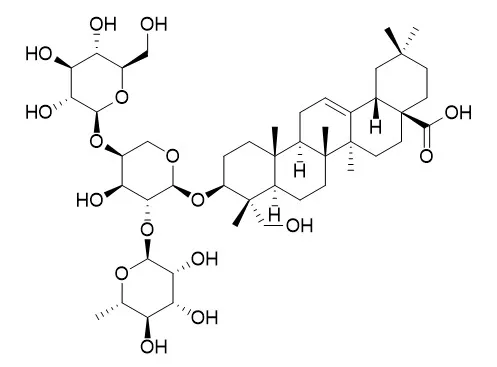| Kinase Assay: |
| Am J Chin Med. 2015;43(8):1657-70. | | Pulsatilla Saponin D Inhibits Autophagic Flux and Synergistically Enhances the Anticancer Activity of Chemotherapeutic Agents Against HeLa Cells.[Pubmed: 26732119 ] | Pulsatillasaponin D (SB365), a saponin isolated from rhizoma of Pulsatilla chinensis (Bunge) Regel, exhibited anticancer activities in various cancer types.
METHODS AND RESULTS:
In the present study, we identified that SB365 was a potent inhibitor of autophagic flux in several cancer cell lines. SB365 induced a robust accumulation of autophagosomes as evidenced by monodansylaervarine (MDC) staining and increased protein levels of LC3-II. However, SB365 caused the accumulation of p62, a substrate that should be degraded through the autophagy-lysosomal pathway. These results indicated that SB365 was an inducer of autophagosome formation, but an inhibitor of autophagic flux. Interestingly, we found that SB365 synergistically enhanced the anticancer activity of chemotherapeutic agents against cervical cancer HeLa cells. Furthermore, our study demonstrated that SB365 increased the phosphorylation of ERK and inhibited the phosphorylation of mTOR and p70S6K, suggesting that their roles in the effects of SB365 on autophagy.
CONCLUSIONS:
These results suggest that SB365 could be a promising adjuvant anticancer agent. | | Carcinogenesis. 2013 Sep;34(9):2156-69. | | SB365, Pulsatilla saponin D, targets c-Met and exerts antiangiogenic and antitumor activities.[Pubmed: 23671132 ] | SB365, Pulsatillasaponin D isolated from the root of Pulsatilla koreana, has exhibited potential beneficial effects as a chemopreventive agent for critical health conditions including cancer. However, the molecular mechanisms underlying the activity of SB365 remain unknown.
METHODS AND RESULTS:
Here, we examined anticancer efficacy of SB365 against gastric cancer and its mechanism of action. SB365 effectively inhibited the growth of gastric cancer cells. Its apoptotic effect was accompanied by increased evidence of cleaved caspase-3 and poly(ADP ribose) polymerase. To elucidate the anticancer mechanism of SB365, we used an array of 42 different receptor tyrosine kinases (RTKs). Of the 42 different phospho-RTKs, SB365 strongly inhibited expression of activated c-mesenchymal-epithelial transition factor (c-Met) in gastric cancer cells. Also, the activation of the c-Met signal cascade components, including Akt and mammalian target of rapamycin, was inhibited by SB365 in a dose-dependent manner. In angiogenesis studies, SB365 inhibited tube formation in hepatocyte growth factor (HGF)-induced human umbilical vein endothelial cells and suppressed microvessel sprouting from the rat aortic ring, ex vivo, and blood vessel formation in the Matrigel plug assay in mice. In xenograft animal models, SB365 significantly delayed tumor growth in a dose-dependent manner. In tumor tissue, SB365 suppressed c-Met signaling, proliferation and angiogenesis and induced apoptosis.
CONCLUSIONS:
These findings suggest that SB365 docks at an allosteric site on c-Met and thereby targets c-Met signaling pathway, cell growth/angiogenesis inhibition and apoptosis induction. Therefore, SB365 may be a novel drug candidate for the treatment of gastric cancer. |
|






 Cell. 2018 Jan 11;172(1-2):249-261.e12. doi: 10.1016/j.cell.2017.12.019.IF=36.216(2019)
Cell. 2018 Jan 11;172(1-2):249-261.e12. doi: 10.1016/j.cell.2017.12.019.IF=36.216(2019) Cell Metab. 2020 Mar 3;31(3):534-548.e5. doi: 10.1016/j.cmet.2020.01.002.IF=22.415(2019)
Cell Metab. 2020 Mar 3;31(3):534-548.e5. doi: 10.1016/j.cmet.2020.01.002.IF=22.415(2019) Mol Cell. 2017 Nov 16;68(4):673-685.e6. doi: 10.1016/j.molcel.2017.10.022.IF=14.548(2019)
Mol Cell. 2017 Nov 16;68(4):673-685.e6. doi: 10.1016/j.molcel.2017.10.022.IF=14.548(2019)